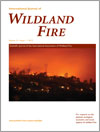International Journal of Wildland Fire
Volume 21
Number 1 2012
Post-fire tree mortality logistic regression models are an important tool in forest management. We review post-fire coniferous tree mortality logistic regression models in western USA and synthesise explanatory variables, model limitations, factors influencing model scope and model validation efforts. Considering previous use of logistic regression models, we recommend future research.
Can satellite products help managers accurately map fire boundaries? We tested the ability of burned area algorithms run on MODIS satellite data to identify burned areas in the Mediterranean shrublands of South Africa. To this end, we compared these satellite derived products with fire boundaries that had been carefully mapped in the field.
Vegetation flammability was weakly dependent on time since last fire; extensively forested areas had short fire return intervals and a high dependence on fuel age; ignoring small fires has little or no effect on the estimates of Weibull function parameters; disregarding censored fire return intervals overestimates fire frequency.
Abundance of native perennial plants continued to decrease with subsequent fires, whereas abundance of the invasive annual grass Bromus rubens increased equally after single or multiple fires. Thus, revegetation of native perennials is most warranted following multiple fires and control of B. rubens is equally warranted after any fire.
Wildfires had a higher effect on gross ammonium transformation rates in soils than prescribed fires relative to their controls. Both types of fires significantly increased soil nitrate concentrations. This was not caused by increased nitrate production, but decreased nitrate uptake by soil microbes.
We analysed if wood piles built up as erosion barriers in burned areas determined the distribution of bird-dispersed plants. We found a higher cover of these plants within piles than outside them on the dry southern slopes. Therefore, wood piles are important to the occurrence of bird-dispersed plants in burned and managed Mediterranean forests.
The purpose of this paper is to report on fire history research from three sites located along a 300-km north–south transect in central Mongolia and to highlight the potential of this region as a test case for understanding the relationships between climate change, fire and land use.




